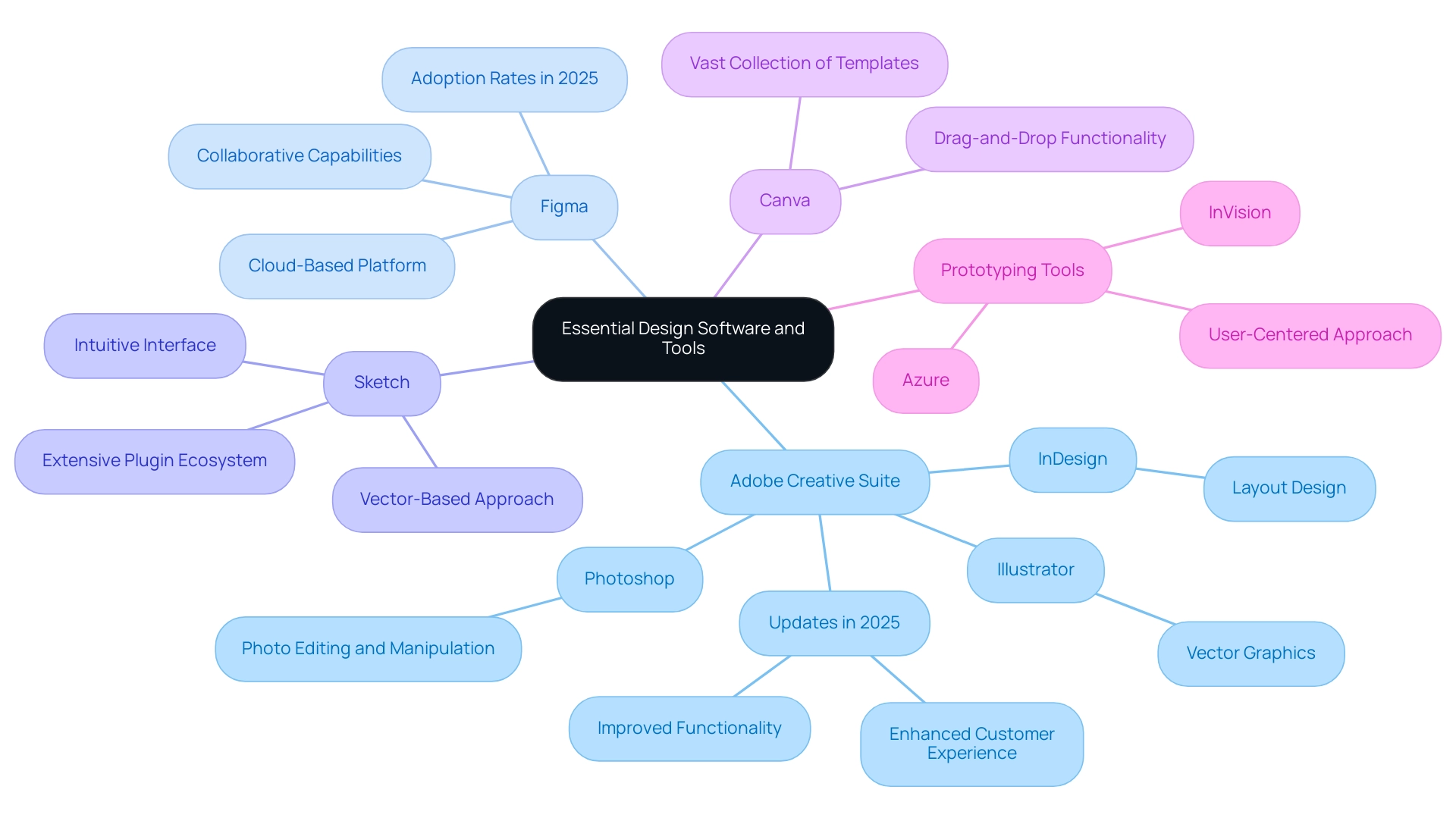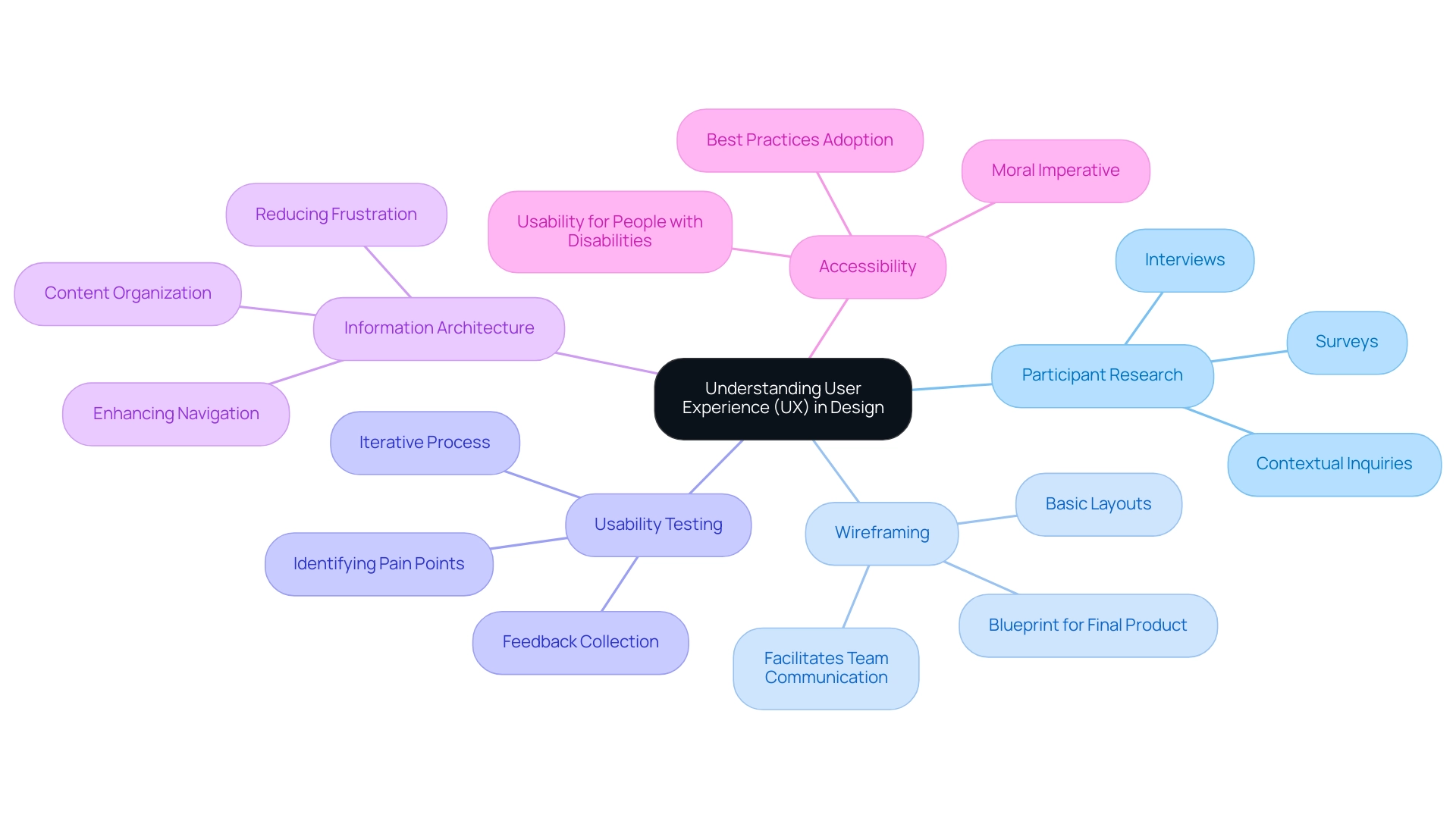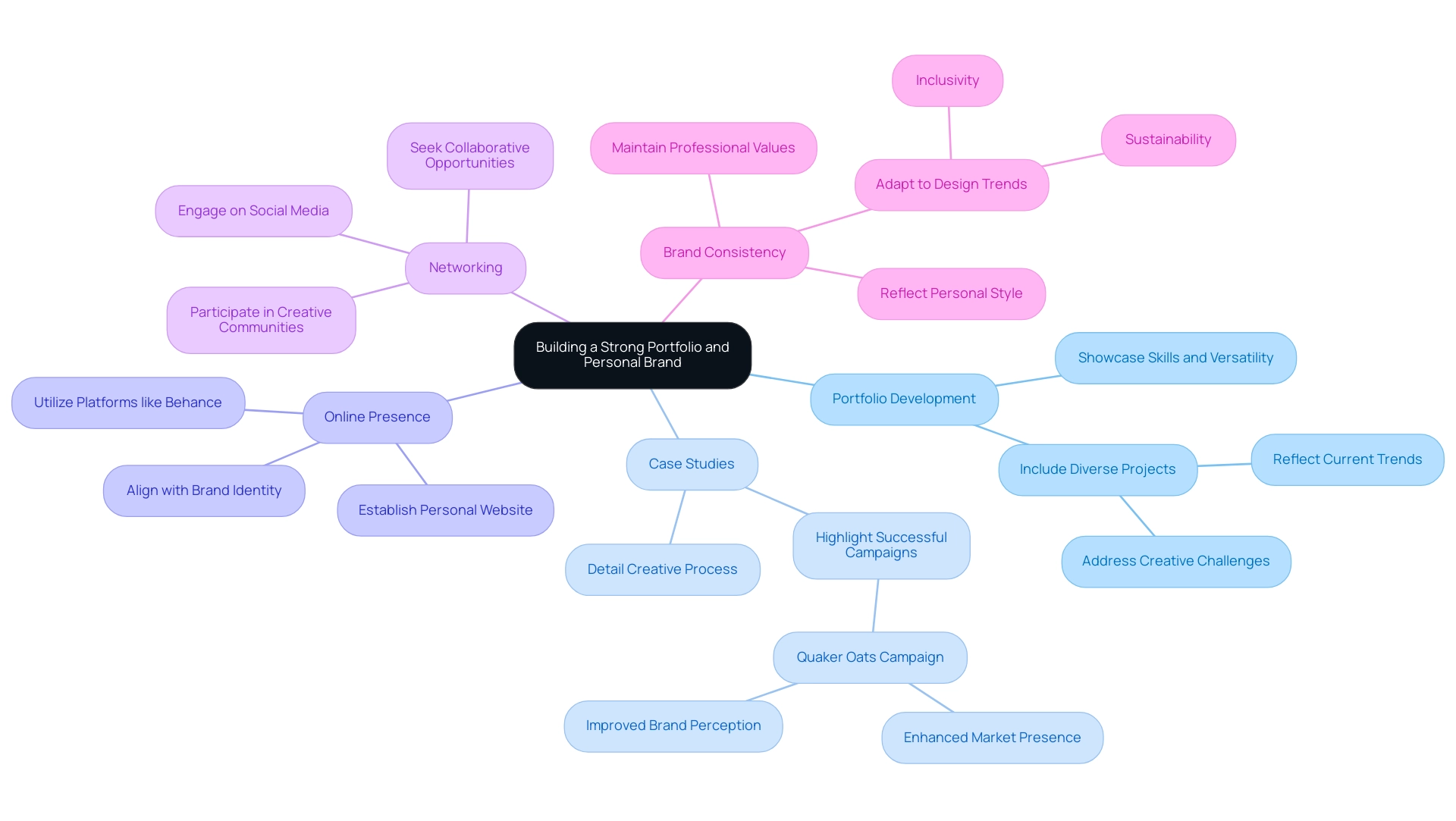Digital Branding Strategies
Web and Graphic Design Skills Checklist: Essential Competencies for Designers
Overview
The article emphasizes the essential competencies that graphic and web designers must cultivate to thrive in their profession. It outlines critical skills such as:
- Creativity
- Technical proficiency
- A deep understanding of user experience
These competencies are not merely advantageous; they are vital for crafting impactful designs and maintaining a competitive edge in the ever-evolving landscape of design as we approach 2025. As the industry continues to transform, embracing these skills will be crucial for designers aiming to succeed.
Introduction
In the dynamic realm of graphic and web design, the landscape is in a constant state of evolution, presenting both challenges and opportunities for creative professionals. As we approach 2025, mastering core competencies such as creativity, technical proficiency, and user experience is more critical than ever.
Designers must not only harness the latest tools and software but also adopt a mindset of continuous learning and adaptability to excel in a competitive market.
This article explores the essential skills and strategies that define successful designers today, emphasizing the integration of artistic vision with technical expertise to create impactful and engaging designs that resonate with audiences worldwide.
Core Competencies in Graphic and Web Design
- Creativity: The ability to generate innovative ideas and solutions is paramount in graphic arts. At WonderEight, creativity remains a critical competency in 2025, driving the development of unique branding strategies that resonate with audiences. Successful projects, such as the brand identity uplift for Castania, exemplify how our creative approaches can lead to significant market differentiation.
- Technical Proficiency: Mastery of software and tools is essential for executing complex projects. As the industry evolves, staying updated with the latest technologies and software is crucial for creators at WonderEight. This technical expertise not only enhances the quality of work but also ensures that our creators can implement creative ideas effectively.
- Attention to Detail: Precision in artistic work is vital for maintaining high standards of quality. At WonderEight, attention to detail ensures that every component of a layout aligns with the overall company message and aesthetic, contributing to a polished final product.
- Time Management: The ability to effectively manage deadlines and project timelines is crucial in a fast-paced environment. Creatives at WonderEight must balance multiple projects while ensuring that each meets client expectations and is delivered punctually.
- Problem-Solving Skills: Addressing creative challenges innovatively is a key competency for professionals at WonderEight. The ability to think critically and develop innovative solutions can significantly impact the success of a project. For instance, the marketing strategy created for Quaker Oats involved overcoming competitive market challenges through a blend of creative branding and digital marketing initiatives, resulting in improved brand recognition and consumer engagement.
In summary, the integration of creativity and technical proficiency is essential for success in web and graphic design. As trends continue to evolve in 2025, creators at WonderEight must cultivate these competencies to remain competitive and deliver impactful solutions.
Technical Skills Every Designer Should Master
Mastery of HTML and CSS is indispensable for web and graphic design, forming the backbone of any website. These languages empower creators to develop structured, visually appealing, and responsive web and graphic design pages. As we approach 2025, the integration of AI in web development is anticipated to automate tasks and optimize website functionality, making proficiency in these languages even more critical.
- Web and Graphic Design Software: Proficiency in industry-standard tools such as Adobe Photoshop, Illustrator, and Figma is essential for successful web and graphic design projects. These applications enable creators to produce stunning visuals and user interfaces that enhance brand identity. Recent updates in graphic creation software have introduced features that streamline workflows and enhance collaboration, making it imperative for creators to stay current with these advancements.
- Responsive Layout: Understanding how to create layouts that adapt seamlessly across various devices is crucial in web and graphic design. With a substantial share of web traffic originating from mobile devices, adaptive layouts ensure a uniform experience for users, regardless of platform. This trend is becoming increasingly significant as preferences evolve, with 46% of website visitors favoring blue in design. This preference underscores the need for careful color selections in responsive layouts to improve engagement.
- Basic Coding: Familiarity with JavaScript and other programming languages can significantly enhance a creator’s capabilities. This knowledge allows for the implementation of interactive elements that boost engagement and overall site functionality. As augmented reality (AR) continues to gain traction in e-commerce and other fields, designers who understand coding will be better equipped to create immersive experiences. For instance, AR can facilitate interactive product displays that elevate user experience and engagement.
- SEO Basics: A foundational understanding of search engine optimization is vital for improving web visibility. Designers who incorporate SEO principles into their web and graphic design can help ensure that websites rank higher in search results, driving more traffic and enhancing visibility. As Maria Harutyunyan states, “Discover the top transportation SEO companies to drive visibility and improve rankings for transportation businesses in search results.” This is particularly relevant as businesses increasingly rely on digital channels to reach their audiences.
- Current Trends in HTML/CSS Usage for 2025: The latest trends indicate a shift towards more semantic HTML and CSS Grid layouts, which enhance accessibility and improve site performance. Designers should be adept at utilizing these modern techniques to create efficient and user-friendly websites.
- Case Studies on Mastering HTML/CSS in Web and Graphic Design: Successful projects, such as the tailored marketing strategy for Quaker Oats, illustrate the importance of mastering HTML and CSS in web and graphic design. By aligning aesthetics with brand goals, WonderEight demonstrated how effective web aesthetics can lead to enhanced brand positioning and consumer loyalty.
- Expert Insights: Experts emphasize that mastering HTML and CSS transcends mere coding; it’s about understanding how these languages interact with principles of aesthetics to create cohesive and functional web and graphic design. This knowledge is increasingly recognized as a key competency for designers in today’s digital landscape.
- Statistics on Graphic Creation Software Usage: Recent surveys indicate that a significant majority of professionals rely on graphic creation software to execute their projects effectively. Staying proficient in these tools is essential for maintaining a competitive edge in the industry.
Creative Skills: The Art of Design
- Visual Storytelling: In today’s digital landscape, the ability to convey messages through imagery and design is not just important; it is essential. Effective visual storytelling captures attention and fosters emotional connections with audiences. Research shows that tweets featuring visual content receive 150% more retweets than those with text alone, highlighting the undeniable power of imagery in communication. As we look towards 2025, the emphasis on visual storytelling will continue to grow, with companies striving to connect with a broader, more global audience through compelling narratives. Emily Stevens, a writer for the UX Design Institute Blog, aptly states, “Visual storytelling aims to develop an emotional connection with the audience by using imagery that resonates with them.” WonderEight exemplifies this approach through its comprehensive campaigns for brands like Mirinda and Quaker Oats, which have successfully resonated with audiences and bolstered loyalty.
- Color Theory: Understanding the impact of colors on emotions and perceptions is fundamental for designers. Color theory is pivotal in marketing, influencing consumer behavior and brand recognition. Research indicates that the strategic application of color theory can significantly enhance identity and emotional resonance. At WonderEight, successful creative projects often leverage color intentionally to evoke specific emotions, thereby amplifying the overall impact of the message. This strategic use of color has been crucial in the agency’s capacity to deliver effective marketing solutions.
- Typography: Mastery of font selection and layout is paramount for effective communication in design. Typography influences not only readability but also reflects the personality of the organization. Designers at WonderEight are tasked with the careful selection of fonts that align with the brand’s voice and message, ensuring that the text complements the visual elements rather than detracting from them.
- Concept Development: Proficiency in brainstorming and developing creative concepts is vital for crafting innovative solutions. A robust concept serves as the bedrock for all creative work, guiding the visual direction and ensuring alignment with the client’s objectives. Collaborative brainstorming sessions at WonderEight often yield unique ideas that resonate with target audiences, driving impactful results.
- Artistic Techniques: A deep knowledge of various artistic styles and methods enriches a creator’s toolkit. Familiarity with diverse techniques empowers creators at WonderEight to experiment and push creative boundaries, resulting in distinctive and memorable creations. This versatility is particularly crucial in a competitive market where differentiation is essential for brand success.
Essential Design Software and Tools
- Adobe Creative Suite: As a cornerstone of graphic artistry, Adobe Creative Suite encompasses powerful tools such as Photoshop, Illustrator, and InDesign. These applications are essential for producing high-quality visuals. Photoshop leads the way in photo editing and manipulation, Illustrator excels in vector graphics, and InDesign stands out as the preferred choice for layout. The suite’s updates in 2025 further enhance customer experience and functionality, reinforcing its crucial role in the creative sector. Notably, 19.6% of marketers face challenges in producing engaging visuals, underscoring the necessity of adept software like Adobe Creative Suite to overcome these hurdles.
- Figma: This application has gained immense popularity among UI/UX creators due to its collaborative capabilities and cloud-based platform. Figma allows multiple users to work on a project simultaneously, making it ideal for teams. As of 2025, Figma’s adoption rates among UI/UX professionals have surged, reflecting its effectiveness in streamlining the creation process and facilitating real-time feedback. Furthermore, with approximately 1 in 5 marketers dedicating over 20 hours weekly to visual content creation, the efficiency provided by Figma is indispensable.
- Sketch: Renowned for its intuitive interface, Sketch is widely utilized for web and mobile development. Its vector-based approach and extensive plugin ecosystem make it a favorite among creators aiming to develop responsive and interactive interfaces.
- Canva: This accessible tool is perfect for quick tasks, enabling individuals to craft professional-looking graphics without extensive skills. Its drag-and-drop functionality and vast collection of templates cater to a broad spectrum of creative needs, from social media posts to presentations.
- Prototyping Tools: Tools like InVision and Azure are crucial for creating interactive prototypes that allow creators to visualize user flows and interactions. These tools empower creators to test and iterate on their concepts before final implementation, ensuring a user-centered approach.
The landscape of web and graphic design, particularly in UI/UX creation, is continuously evolving. Tools like Adobe Creative Suite and Figma lead the charge, aiding designers in overcoming challenges faced by the 19.6% of marketers who struggle with crafting compelling visuals. Case studies, such as the successful implementation of Adobe GenStudio, illustrate how these tools can streamline content management and enhance messaging consistency. Additionally, WonderEight’s commitment to merging creativity with technology is evidenced in their success stories, including the brand identity enhancement for Castania and the digital campaign for Motorola, showcasing the tangible impact of these creative tools.

Understanding User Experience (UX) in Design
- Participant Research: Conducting surveys and interviews is essential for understanding participant needs. Effective research techniques, such as contextual inquiries and usability testing, enable creators to collect valuable insights that guide decision-making. Statistics indicate that companies prioritizing user research can significantly improve their conversion rates; for instance, HubSpot has doubled and tripled their conversion rates in some areas after revamping their website’s UX. This underscores the impact of employing user-centered planning strategies.
- Wireframing: Creating basic layouts to visualize concepts is a critical step in the process. Wireframing serves as a blueprint for the final product, enabling creators to explore various layouts and functionalities before progressing into detailed planning. As we move through 2025, the significance of wireframing continues to grow, facilitating effective communication among team members and stakeholders, ensuring alignment on the vision. A well-executed wireframe can greatly enhance the overall experience by providing clarity and guidance throughout the creation process.
- Usability Testing: Evaluating layouts with actual participants is crucial for collecting feedback and enhancing experiences. This iterative process aids in identifying pain points and opportunities for improvement, ultimately resulting in more intuitive and user-friendly solutions. Expert opinions emphasize that usability testing should be a continuous practice, allowing designers to adapt to evolving audience needs and preferences. As Ella Webber aptly states, “AI can’t replicate human empathy and creativity—crucial for understanding audience needs and making intuitive design judgments,” underscoring the irreplaceable role of human insight in usability testing.
- Information Architecture: Organizing content effectively for navigation is vital in enhancing user experience. A well-structured information architecture ensures that individuals can easily find what they are looking for, reducing frustration and increasing engagement. In 2025, the emphasis on clear information architecture is more crucial than ever, as individuals expect seamless navigation across digital platforms.
- Accessibility: Ensuring creations are usable for people with disabilities transcends legal requirements; it is a moral imperative. Including accessibility in the creation process not only expands audience reach but also enhances overall satisfaction. As awareness of accessibility issues rises, creators are progressively embracing best practices to develop inclusive experiences that cater to everyone. Successful campaigns by brands like Miranda and Quaker Oats exemplify how effective user research and strategy can elevate brand experiences and drive consumer engagement.

Collaboration and Communication Skills for Designers
- Active Listening: Mastering active listening is crucial for designers to fully understand client and team feedback. This skill not only promotes better communication but also enhances collaboration, resulting in more effective outcomes. Research indicates that teams prioritizing active listening experience reduced turnover rates, highlighting its importance in maintaining a cohesive work environment. Furthermore, active listening behavior significantly activates specific brain regions, such as the ventral striatum/thalamus and right insula/IFG, underscoring its neurological significance. Additionally, active listening benefits market research by enhancing client relationships and improving data quality, making it a vital skill across various contexts.
- Presentation Skills: As we approach 2025, the ability to effectively showcase creative concepts to stakeholders is more important than ever. Designers must be adept at presenting their ideas clearly and persuasively, ensuring that their vision resonates with clients and decision-makers. Effective presentation abilities can significantly influence project success, as they help convey the value of creative choices and foster stakeholder buy-in.
- Feedback Reception: Being open to constructive criticism is essential for designers aiming to refine their work. Embracing feedback not only enhances creations but also showcases a dedication to growth and collaboration. Designers who actively seek and incorporate feedback are more likely to produce work that meets client expectations and drives project success. As Shane Snow pointed out, growth and evolution are essential elements of success in any area, including creativity.
- Team Collaboration: Effective cooperation with cross-functional teams is vital in the creative process. Designers must engage with various stakeholders, including marketers, developers, and product managers, to ensure that all perspectives are considered. Strong collaboration skills lead to more innovative solutions and a unified approach to project execution.
- Conflict Resolution: Navigating disagreements and finding common ground is an essential skill for those in the creative field. Conflicts can arise during the design process, whether due to differing opinions on aesthetics or functionality. Designers who can effectively mediate these discussions and reach consensus will contribute to a more harmonious and productive team environment. By employing active listening techniques and demonstrating empathy, creators can facilitate constructive dialogues that lead to better outcomes. Practical strategies for improving active listening skills include paying full attention, asking clarifying questions, summarizing key points, showing empathy, avoiding interruptions, and being patient.
The Importance of Continuous Learning and Adaptability
- Online Courses: Platforms such as Coursera and Skillshare offer a vast array of courses specifically designed for creatives, empowering them to acquire essential skills and remain abreast of industry trends. With the online learning market projected to surpass 1.1 billion consumers by 2029, the appetite for design-related courses is escalating. Notably, the number of undergraduates enrolled exclusively in online college courses surged from 2.4 million to 7 million between 2019 and 2020, underscoring the burgeoning interest in online education.
- Networking: Engaging with creative communities is paramount for knowledge sharing and experience exchange. In 2025, statistics reveal that networking within these communities can substantially enhance career opportunities, with numerous professionals reporting heightened collaboration and job prospects through active participation. As Luisa Zhou articulated, “Industry insights revealed that three-quarters of schools in the United States plan to operate either completely remote or via a hybrid learning model this school year,” highlighting the transition towards online engagement.
- Workshops and Conferences: Participating in industry workshops and conferences is vital for staying informed about the latest trends and technologies in web and graphic design. These events not only deliver valuable insights but also cultivate connections with industry leaders and peers. A case study indicated that 90% of companies provide some form of digital learning to employees, accentuating the significance of continuous learning in professional development.
- Experimentation: Regularly experimenting with new tools and techniques is crucial for broadening a creator’s skill set. This hands-on approach fosters creativity and innovation, equipping creators to adapt to evolving market demands. Client success stories, such as the brand identity enhancement for Castania and the digital campaign for Motorola, illustrate how ongoing learning and experimentation can yield measurable results in creation.
- Feedback Loops: Actively soliciting feedback on one’s work is an essential practice for pinpointing areas for growth. Constructive feedback from colleagues and mentors can lead to significant improvements in quality and effectiveness, ultimately enhancing a creator’s portfolio and career trajectory.
Building a Strong Portfolio and Personal Brand
-
Portfolio Development: Curate a selection of your best work that effectively showcases your skills and versatility as a designer. A well-organized portfolio not only highlights your aesthetic sensibilities but also demonstrates your ability to tackle creative challenges. In 2025, it is crucial to include a diverse range of projects that reflect current trends and technologies, as 19.6% of marketers report difficulties in creating engaging visuals. As noted by Sufio, the Ancient Egyptians are recognized as some of the earliest creators of logos, underscoring the enduring significance of effective aesthetics in branding.
-
Case Studies: Incorporate detailed explanations of your creative process and outcomes within your portfolio. Successful case studies, such as the comprehensive campaign developed for Quaker Oats by WonderEight, exemplify how strategic thinking and creativity can enhance product perception and drive sales growth. By outlining the challenges faced, the solutions implemented, and the results achieved, you provide potential clients with a clear understanding of your capabilities. Highlighting case studies is essential, as they serve as concrete evidence of your creative effectiveness and problem-solving skills.
-
Online Presence: Establish a personal website or utilize platforms like Behance to effectively showcase your work. An online portfolio not only increases your visibility but also facilitates easy sharing of your projects with potential clients and collaborators. Ensure that your online presence is professional and aligns with your brand identity.
-
Networking: Actively engage with other designers and potential clients through social media platforms. Establishing a network can lead to collaborative opportunities and referrals, which are vital for career advancement in the creative field. Participate in creative communities and forums to share insights and receive feedback on your work.
-
Brand Consistency: Ensure that your portfolio reflects your personal style and professional values. Consistency in branding across your portfolio helps establish your identity as a designer and makes your work more recognizable. This alignment not only attracts clients who resonate with your style but also reinforces your commitment to quality and professionalism. Additionally, consider the evolving landscape of graphic design, which is adapting to technological advancements while emphasizing inclusivity and sustainability, as these trends can significantly influence your design approach and portfolio presentation.

Conclusion
The graphic and web design industry is on the brink of a significant transformation as it approaches 2025. To thrive in this dynamic environment, designers must cultivate a diverse skill set that intertwines creativity with technical proficiency. Mastery of essential tools such as Adobe Creative Suite and Figma, coupled with foundational coding skills, not only enhances the quality of design work but also empowers designers to create user-centric solutions that resonate with audiences.
Moreover, understanding user experience (UX) principles—including user research, wireframing, and usability testing—remains critical for crafting engaging and accessible designs. The incorporation of effective communication and collaboration skills into the design process fosters a more cohesive workflow, enabling teams to innovate and adapt to challenges more efficiently.
Continuous learning and personal branding have emerged as indispensable elements for success in this competitive field. Designers are encouraged to engage in online courses, networking, and experimentation with new techniques to stay ahead of industry trends. A robust portfolio that showcases versatility and strategic thinking can significantly enhance career prospects, making it essential to highlight not just aesthetic sensibilities but also problem-solving capabilities.
As the design landscape evolves, those who embrace adaptability and foster a mindset of growth will be best positioned to make impactful contributions. The integration of artistic vision with technological advancements will ultimately define the future of graphic and web design, allowing designers to create compelling narratives that connect with audiences worldwide.
Frequently Asked Questions
What competencies are essential for success in graphic arts at WonderEight in 2025?
Essential competencies include creativity, technical proficiency, attention to detail, time management, and problem-solving skills.
Why is creativity important in graphic arts?
Creativity is crucial for generating innovative ideas and solutions, driving the development of unique branding strategies that resonate with audiences.
What role does technical proficiency play in graphic design?
Mastery of software and tools is essential for executing complex projects and enhancing the quality of work, allowing creators to implement their creative ideas effectively.
How does attention to detail contribute to graphic design?
Attention to detail ensures that every component of a layout aligns with the overall company message and aesthetic, contributing to a polished final product.
Why is time management important for creatives at WonderEight?
Effective time management is crucial for balancing multiple projects while ensuring that each meets client expectations and is delivered on time.
What problem-solving skills are necessary for graphic designers?
The ability to address creative challenges innovatively and think critically is key for developing solutions that significantly impact project success.
What technical skills are critical for web and graphic design?
Mastery of HTML and CSS, proficiency in design software like Adobe Photoshop and Illustrator, and basic coding knowledge are critical for successful projects.
How does understanding responsive layout affect web design?
Creating layouts that adapt seamlessly across devices is essential to ensure a uniform experience for users, especially as mobile web traffic increases.
Why is familiarity with SEO principles important for designers?
A foundational understanding of SEO helps improve web visibility, ensuring that websites rank higher in search results and drive more traffic.
What current trends in HTML/CSS should designers be aware of for 2025?
Trends indicate a shift towards more semantic HTML and CSS Grid layouts, which enhance accessibility and improve site performance.
Can you provide an example of the importance of mastering HTML and CSS in design?
Successful projects, like the tailored marketing strategy for Quaker Oats, illustrate how mastering HTML and CSS can enhance brand positioning and consumer loyalty.
What do experts say about the mastery of HTML and CSS?
Experts emphasize that mastering these languages is about understanding their interaction with aesthetic principles to create cohesive and functional designs.



